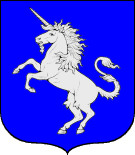You seem to be using an older version of Internet Explorer. This site requires Internet Explorer 8 or higher. Update your browser here today to fully enjoy all the marvels of this site.
January 19, 2019 by Alexander Meldrum
to upload on tartan
The Unicorn Of Scotland As A Heraldic Symbol
Unicorns have been associated with Royalty and heraldry since at least the time of the Romans, and over the centuries their appeara...to upload on tartan
The Unicorn Of Scotland As A Heraldic Symbol
Unicorns have been associated with Royalty and heraldry since at least the time of the Romans, and over the centuries their appearance and personality traits have had more than a few 'upgrades'!
The Unicorn. Scotland's National Animal
They grew to become an exotic creature... a magnificent horse with cloven hooves, the tail of a lion, and a perfect spiraled horn in the middle of their foreheads.
In Celtic Mythology the Unicorn of Scotland symbolized innocence and purity, healing powers, joy and even life itself.
It was also seen as a symbol of masculinity and power. Two sides of the same coin as it were, a blend of male virility and female nurturing - perhaps the perfect mix!
The Unicorn was seen as A wild, freedom-loving creature Fierce, bold, proud and intelligent Beautiful and courageous People also believed it to be a dangerous creature if running free.
One that was impossible to capture alive - unless lured into an ambush by a virgin!
You might notice that when he's featured on heraldic symbols, the Unicorn often has chains wrapped around him. This is a nod to this medieval belief that he was a dangerous creature.
To a country as bold, fierce and proud as Scotland, one that was fighting for it's independence from 'oppressors' this was the perfect choice as the 'National Animal' that would appear on heraldic symbols.
The connection and respect for this creature is clear in this 17th century description written by John Guillim in his 'Displays of Heraldry'....
Some have made doubt whether there be any such beast as this or no, but the great esteem of his horn (in many places to be seen) may take away that needless scruple.
The greatness of his mind is such that he rather chooseth to die than be taken alive; wherein the Unicorn and valiant-minded soldier are alike, which both contemn death, and rather than they will be compelled to undergo any base servitude or bondage they will lose their lives'
It's not quite clear exactly when the Unicorn first appeared in Scottish heraldry, but one of the earliest examples is seen in the 'Royal Coat of Arms' at Rothesay Castle which is believed to have been carved sometime before the 15th century.
The Scottish Coat of Arms featuring two Unicorns
Before England and Scotland came under joint rule, Scotland's Coat of Arms featured two Unicorns supporting a shield (seem photo above).
In 1603 the reigning King of Scotland, King James VI, also succeeded Queen Elizabeth 1st of England and become King James the 1st of England. This was known as the Union of the Crowns.
Although the new country of Great Britain did not legally exist for another century, this union seemed to require a new Royal Coat of Arms, and work began on creating the design you see today which features the Unicorn of Scotland on the right, and the English Lion on the left.
The Lion & The Unicorn - Traditional Nursery Rhyme Poster
The use of both symbolic creatures was supposed to symbolize the accepted union of the two countries.
But in real life the actual union was less than friendly, and this conflict was immortalized in the well-known British Nursery Rhyme....
The Lion & The Unicorn'
The lion and the unicorn
Were fighting for the crown
The lion beat the unicorn
All around the town
Some gave them white bread
And some gave them brown
Some gave them plum cake
And drummed them out of town
By now I'm sure you can see why this mythical creature is the perfect National Animal of Scotland.
Hopefully you've also enjoyed learning a bit more about the magic and reality of this fantastic creatures' role in Scottish heraldry.
Go to Wikipedia for full History
In this photo:


